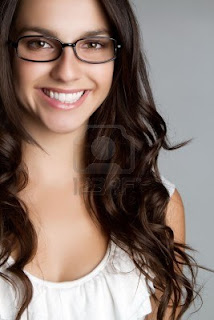FACE SHAPE
There are seven basic face shapes: oval, round, heart, oblong, triangle, square and diamond.
You should select frames that offset the shape of the face with the frame. For example, instead of a round frame on a round face, select an angular or rectangular frame.
While our duty is to suggest what looks best based on face shape, ultimately we want customers to be happy so be sensitive to what they think looks best on them. Don't be afraid to vocalize what is best for them based on prescription, skin color, face shape and other factors.
The following are general guidelines for identifying face shape and choosing appropriate styles:
- Oval: Top and bottom of face are well balanced; suggest any style except extreme geometric designs.
- Round: Large curved forehead and rounded chin, face is full without angles; suggest square or angular frames.
- Heart: Forehead is widest part of face that narrows gradually to slightly pointed chin; suggest rimless design.
- Oblong/rectangular: Long narrow face; suggest deep fitting frame from top to bottom or a frame with deep B measurement.
- Triangle: Narrow head, face gradually becomes fuller at cheeks and chin -- rimless designs.
- Square: Wide forehead cheeks and chin where jaw is angular in appearance -- hard jaw line -- round frames.
- Diamond: Small forehead, wide temple that gradually decreases to a small chin area -- oval or avoid angular.
FIT
Make sure eyes are centered in the frame. This is the most important factor in choosing a frame especially with strong prescriptions and progressive lenses. Regardless of lens material, if the eye is properly centered, the lenses will come out thinner. (least amount of decentration = less lens edge thickness Make sure temples are long enough so that they can be adjusted properly.
Short temples look horrible and will cause unwanted tilt and thus alter the way one sees through their glasses. Short temples or ill-adjusted temples are the sign of a bad optician, so be super sensitive to this.
Assess size of nose to see if a large or narrow bridge is best. Use large bridge for wide noses or a narrow bridge (generally with nose pads) for narrower noses to ensure proper fit.
Certain bridges can enhance or draw attention away from a large nose. Frames that fit close to a large nose will minimize the size and focus attention to the frame. The idea is to limit the amount of space from the bridge of the nose to the bridge of the frame. The more space left between (frame and nose) will make a nose even appear larger than it already is! Metal frames work a bit better in some cases and as a plastic frame can give the appearance it's attached to the nose and might actually come off with the glasses! (Think Groucho Marx.)
A narrow/small frame bridge on a large nose will push the frame up on the face and prevent the wearer from looking through the centers of the lenses, cause terrible marks on the nose and look horrible.
Small or narrow noses require small bridges. If a frame bridge is too large for a nose it will leave a horrible mark on the top of a person's bridge. If it is metal it could even cut the skin.
Remember that nose pads can be mounted onto plastic frames to achieve a better overall fit. For example, if someone has a flat nose and the frame is resting on their checks, adding nose pads can be the perfect solution.
If necessary, make some minor adjustments to a frame during the final selection to give the customer a better idea of how the frame will fit.
When selecting frames that will accommodate progressive lenses, you must ensure that the minimum height requirement needed for progressive lenses is met. Always consult with an optician if you are unsure. Often times adjustments can be made to the frame (e.g. opening the bridge, changing the angle) or altering the add power of the RX that will allow it to work with a progressive lens.









0 comments:
Post a Comment